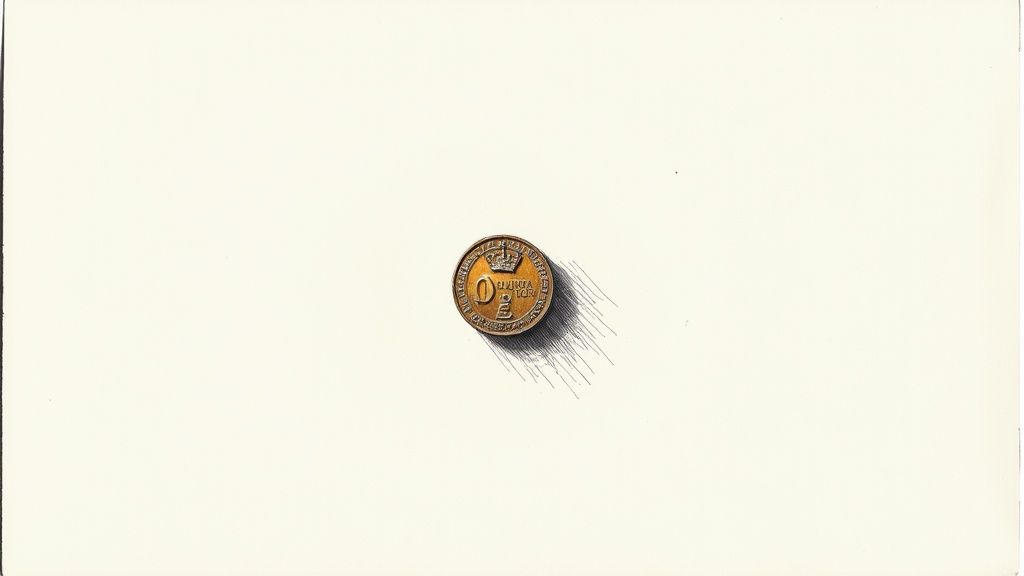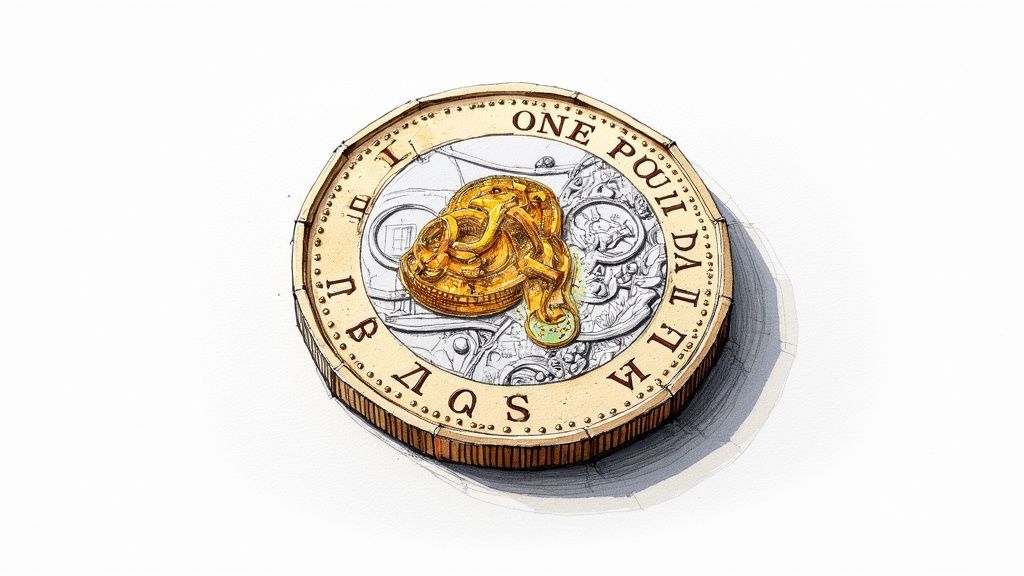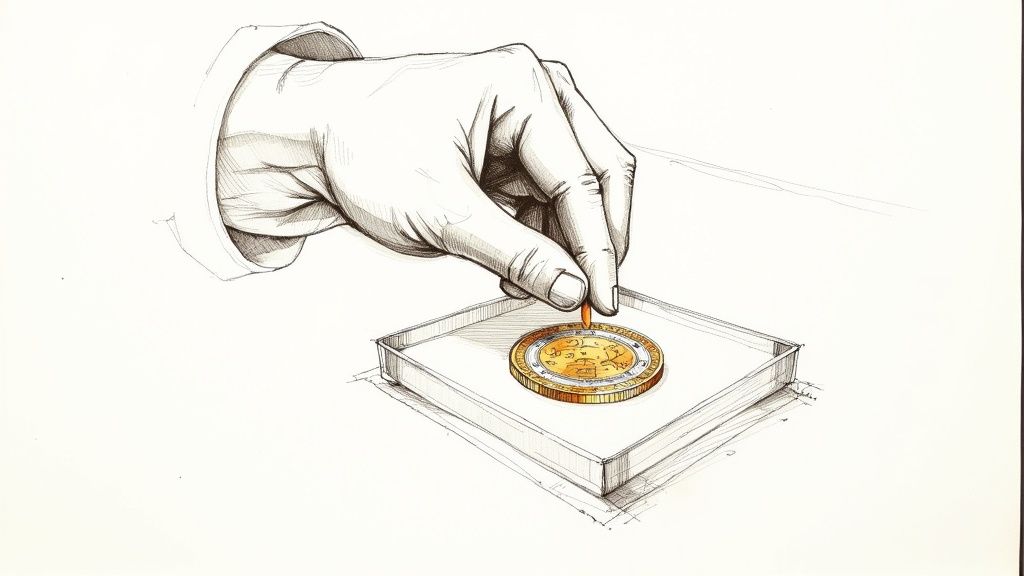Learn the Value of One Pound Coin – Find Out What It’s Worth!

Posted by: Ian • 29 Sep 2025
That one pound coin rattling around in your pocket is worth exactly a quid for a pint of milk, but its true value could be much, much more. For collectors, a coin's backstory, rarity, and condition can turn it from loose change into a proper little treasure.
Figuring out what makes one coin more valuable than another is the first step to uncovering whether you're sitting on a hidden gem. This guide provides helpful advice and real-world insights on what to look for and how to easily exchange foreign coins, leftover holiday money, and old or obsolete currency.
More Than Just a Pound: Uncovering Your Coin's True Worth

Most of us see a £1 coin and just think of its face value—the number stamped on it. That’s its legal tender value, what you can use to buy things. But there are other ways to look at a coin's worth that go far beyond its spending power.
Understanding the Three Types of Value
The real story behind a coin’s value comes down to three key ideas. Each one gives you a different angle on what your pound coin might actually be worth. To keep it simple, here’s a quick look at how we, and other experts like in this a pawnbroker's guide to valuation, assess currency.
Below is a quick summary of the key factors that determine what your £1 coin is really worth.
At a Glance: How Pound Coins Are Valued
| Value Type | What It Means | Potential Worth |
|---|---|---|
| Face Value | The simplest one. It's the amount stamped on the coin. | £1 |
| Melt Value | The value of the actual metals used to make the coin. | Usually low for modern coins, but can be higher for older issues. |
| Collector Value | What a collector will pay, based on rarity, condition, and demand. | Can be many times the face value for the right coin. |
The collector value, sometimes called numismatic value, is where things get really interesting. This is where a common piece of pocket change can become a sought-after collectible, sometimes fetching hundreds of pounds. A rare design, a mistake during minting, or a coin from a very limited run can make its value skyrocket.
It's this hidden potential that makes coin collecting so exciting.
Whether you've got old round pounds, leftover foreign currency, or a bag of mixed coins, turning it into cash should be simple. Our service is designed to be fast, easy, and hassle-free, with a 100% guarantee on our valuation. Plus, there's no need to sort coins. We are trusted by major brands, including charities, supermarkets, airports, and even police forces, to provide a credible and efficient way to exchange foreign coins and notes.
The Story of the Modern Pound Coin
To really get a feel for a one pound coin's value, you have to know its story. The modern £1 coin we use today didn't even exist until 1983, when it was rolled out to replace the flimsy £1 banknote that was getting a bit long in the tooth. This original "round pound" served the nation for over three decades, becoming a familiar jingle in purses and pockets across the UK.
Made of a simple nickel-brass, the original coin was an everyday workhorse. By March 2016, there were an estimated 1.671 billion of them in circulation, which shows just how vital they were to daily life.
But its popularity had a dark side. The simple design made it an easy target for counterfeiters. As forgery techniques got slicker, the Royal Mint knew something had to change to protect the integrity of our currency. That realisation kicked off a complete redesign, marking a brand new chapter for the humble quid.
The Evolution to a Modern Classic
This timeline shows how the UK one pound coin went from its straightforward beginnings to the high-tech, secure version we have now.

The infographic really drives home the shift from the old round design to the advanced bimetallic coin—a change driven purely by the need for better security.
In 2017, the iconic round pound was officially retired. Its replacement was the 12-sided, bimetallic version you see today. This new coin wasn't just a pretty face; it was packed with security features like a latent image and micro-lettering, making it one of the most secure coins in the world. You can find out more in our guide to the new one pound coin from 2017.
This journey from a simple design to a high-tech one reflects the constant cat-and-mouse game with counterfeiters. For collectors, this evolution creates distinct eras, making coins from certain periods much more interesting and desirable.
Understanding this story—from the trusted old round pound to its secure successor—is the key to spotting valuable issues. It’s the very reason why certain designs, mintage years, and royal portraits grab more attention and fetch a higher price among enthusiasts.
How to Spot a Rare One Pound Coin in Your Change

You don’t need to be a seasoned coin expert to find a hidden gem in your pocket. Honestly, you just need to know what to look for. The things that really push a one-pound coin's value up are low mintage numbers, unusual designs, and the occasional minting error.
When a coin has a "low mintage," it just means the Royal Mint didn't produce very many of them. This makes it scarce from the day it was struck, and that's what gets collectors excited. They're often happy to pay well over face value to fill a gap in their collection.
Key Features to Check on Your Coins
Next time you get a handful of change, just take a quick moment to give the £1 coins a once-over. The first thing to check is the date and the design on the reverse (the "tails" side). Some designs were only minted for a single year in tiny quantities, making them instantly more desirable.
Here are some practical tips on what to look for:
- Low Mintage Figures: Check the year. The old round pounds from 2011, featuring Edinburgh City and Cardiff City, are famously hard to find because so few were made. For a closer look at older designs, check out our guide on the old 1 pound sterling coin from Great Britain.
- Minting Errors: Look for anything that seems a bit… off. This could be anything from a misaligned strike where the design isn't centred, to incorrect lettering or even the wrong date. These mistakes are rare, and that rarity can make a coin surprisingly valuable.
- Commemorative Designs: Special coins celebrating national events or famous landmarks often have smaller production runs. The 2017 "Nations of the Crown" design is a great modern example to watch for.
One of the biggest moments for collectors recently was the switch from coins featuring Queen Elizabeth II to those with King Charles III. This changeover created instant modern rarities.
The Royal Mint released millions of £1 coins dated 2021 and 2022 with the Queen's final portrait. But the 2022 coins, with a limited run of just 7.735 million, have become some of the rarest modern £1 coins in circulation, marking the true end of an era.
Of course, these aren't the only things to look for. There are plenty of general tips for identifying valuable coins that apply to all kinds of currency. Getting familiar with these details is the best way to spot treasure where others just see spare change.
Bullion and Commemorative Pound Coins: More Than Just Change
A one-pound coin is usually just that—a pound. But step into the world of collectors and investors, and you'll find that some pound coins are worth a whole lot more than their face value. These aren't the coins you use to buy a coffee; they're special issues crafted from precious metals like gold and silver.
These valuable coins generally fall into two categories: bullion and numismatic.
Bullion coins are all about the metal. Their worth is directly tied to the current market price of the gold or silver they contain, making them a popular choice for investors. Numismatic coins, on the other hand, are prized by collectors for their rarity, historical importance, and unique design.
Knowing the difference between these two is the first step in understanding the fascinating history behind British currency.
The Legendary Gold Sovereign
The most famous example has to be the Gold Sovereign. It was the original pound coin, first minted all the way back in 1489 for King Henry VII. While it vanished from everyday circulation after the First World War, it was brought back in 1957 as legal tender bullion and has been a favourite of investors and collectors ever since.
Some of these coins can be worth a fortune. A rare 1917 George V Gold Sovereign, for instance, can fetch around £30,000, while the one-of-a-kind 1937 Edward VIII Gold Sovereign is valued at an incredible £1,000,000. You can discover more about the history of pound sterling on auronum.co.uk.
Now, you probably won't find a Gold Sovereign down the back of the sofa, but you might have a stash of leftover foreign currency or old British money tucked away. Turning this forgotten cash into money you can actually spend shouldn't be a chore. Our service is designed to be completely fast, easy, and hassle-free.
Forget about sorting or trying to identify what you have. Just send us your mixed collection of coins and banknotes, and we'll handle everything with a 100% guarantee. We're trusted by major UK brands—including airports, charities, and police forces—to convert foreign coins and banknotes into usable funds, quickly and reliably.
Turn Your Old and Foreign Coins Into Cash the Easy Way

Found a jar of old round pounds? What about a bag of leftover foreign currency from holidays past, or even some old banknotes you’d forgotten about? The next step is turning that forgotten stash into real cash. The thought of sorting through a mountain of mixed coins can feel like a massive chore, but it really doesn’t have to be.
Our service is designed to be completely hassle-free. You don’t need to sort, count, or identify a single coin. We’ve built a fast, easy, and 100% guaranteed process that does all the hard work for you. Simple as that.
A Credible Service Trusted by UK Leaders
Trust is everything in this business. It's why we’re the chosen currency exchange partner for major UK names you’ll recognise, including national charities, supermarkets, airports, and even police forces. They count on our friendly, professional service to handle their currency needs securely and without fuss.
Our expertise isn’t just for the common stuff, either. We convert foreign coins and banknotes of all kinds, including the old, withdrawn, and obsolete money that high street banks simply won't touch. You can get a better feel for what you can exchange by checking out our guide on the easy way to exchange old British coins and notes.
By removing the need to sort coins, we make the process incredibly simple. Just pack up your entire collection—no matter how mixed—and send it to us. It’s the most straightforward way to get value from currency that’s otherwise just gathering dust.
Donate Foreign Coins to Charity
Your leftover travel money can also make a huge difference. We partner with lots of UK charities, giving you a simple way to donate foreign coins to charity. Instead of letting that small change go to waste in a drawer, you can turn it into a meaningful contribution to a cause you care about. It’s a brilliant alternative for your unused currency.
Whether you choose to cash in your collection or donate it, our process ensures you unlock its full potential without any of the hassle. Ready to get started? Head over to our homepage to find out how simple it is to exchange foreign coins and notes today.
Got Questions About Your Pound Coins? We've Got Answers
It's natural to have a few questions when you're figuring out what your coins are worth and how the whole currency exchange thing works. To make things crystal clear, we've tackled some of the most common queries we hear.
Figuring Out What Your Coins Are Worth
Which £1 coins are actually valuable?
The coins that collectors really get excited about are usually the ones with low mintage figures or interesting errors. Think of the 2011 Edinburgh City and 2011 Cardiff City round pounds – they’re notoriously hard to find. More recently, the 2022 Queen Elizabeth II memorial coin is a key one to look for, as not many were made before the changeover. A quick check of official mintage figures is always the best way to gauge a coin's rarity.
How can I tell if my coin has a minting error?
Spotting a minting error takes a sharp eye, but it’s all about looking for something that just isn't quite right. You might see a design that's struck off-centre, text that's wrong, or two sides that don't line up properly. A classic example is the 'Nations of the Crown' £1 coin that famously appeared with a 2016 date on one side and 2017 on the other. Keep an eye out for anything that looks unusual compared to a normal coin.
Swapping Old and Foreign Currency
Can I still do anything with my old round pound coins?
Absolutely. While you can no longer spend the old round £1 coins in shops, they certainly haven't become worthless. Instead of letting them sit in a jar, our fast and easy service lets you exchange foreign coins and notes right alongside your old UK currency, all in one go. It saves you the hassle of a trip to the bank.
What’s the easiest way to handle leftover foreign coins?
Honestly, the most hassle-free way to convert foreign coins and banknotes, especially if you have a mixed bag from different trips, is to use a specialist service like ours. We take all the pain out of the process – there's no need to sort, count, or try to identify anything yourself. Just pop your collection in the post to us. Our 100% guaranteed service is trusted by big names like UK airports, supermarkets and charities, so you know you're in safe hands.
Ready to unlock the cash hiding in your old and foreign currency? At We Buy All Currency, we turn forgotten coins and notes into money in your pocket. Our process is fast, easy, and hassle-free. Better yet, it's 100% guaranteed and there's no need to sort coins. Start your exchange now on webuyallcurrency.com.
